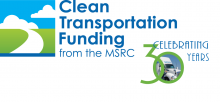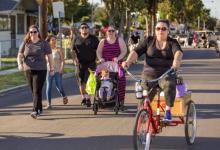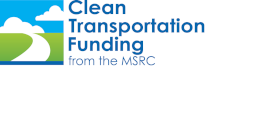
Six more impactful Clean Transportation Funded-projects help to wrap-up our year-long look at 30 projects for 30 years of the MSRC:
- EV1 buy down program (early 1990s)
In the early days of the MSRC, the EV1 Consumer Buydown Program was one of the first funding programs offered. The program allocated $5 million for EVs, and offered $5,000 grants to EV buyers and lessors. The EV1 rebate program marked the first time the MSRC invested in the electric vehicle future and helped pave the way for other vehicle incentive programs. The MSRC helped develop new technology by working with auto manufacturers and helped jump start the battery programs for some of them. Some of the success of today’s EVs stems from this era of early adoption.
- CR&R RNG facility (multi-year)
The MSRC partnered with CR&R Environmental Services on a state-of-the-art facility in Perris that uses an anaerobic digester to generate its own cleaner-burning transportation fuel. The MSRC provided funding for multiple stages of the project, from the original installation of the first fueling pumps to its various levels of expansion over the years. CR&R’s Inland Empire Facility accepts organic waste from the region, diverting it from local landfills and capturing the methane produced when the waste is processed. The “biogas” generated is cleaned and converted into renewable natural gas (RNG), which is used to operate CR&R’s fleet of more than 100 natural gas refuse trucks servicing Southern California.
- Open Streets projects (multi-year)

Over the years, the MSRC has provided funding for many open streets and pedestrian friendly projects. Open Streets events temporarily close normally busy streets to motor vehicle traffic in order to encourage active transportation modes such as bicycling and walking as a better and cleaner way to get around. The MSRC partnered with the Southern California Association of Governments on its Go Human campaign, which encourages local residents to use human-powered transportation, and helped sponsor several open streets events in San Bernardino, Riverside and Orange Counties (see photo). Additionally, the MSRC has funded projects to encourage biking and walking like the Buena Park pathway project. The pathway runs through the center of the city, providing a 12-foot wide concrete path and an 8-foot wide decomposed granite path ideal for walking, running and biking. The path connects to existing pathways in neighboring cities, and city leaders hoped to be able to expand the trail to provide a seamless walking path throughout the city.
- Angels Stadium Express (multi-year)
In 2011, the MSRC began its partnership with the Los Angeles Angels on the Angels Express, helping fans get to the stadium using public transportation. The Angels Express offered dedicated Metrolink trains that operated along the Orange County Line corridor from Laguna Niguel/Mission Viejo in the south and Los Angeles Union Station in the north to the Metrolink Anaheim Station, located a few hundred feet from the stadium entrance. The program was a part of the MSRC’s Major Event Center Program, designed to help get event attendees out of their cars and onto public transportation when traveling to major venues that aren’t served by regularly scheduled transit service. The Angels Express connected passengers to a variety of transit modes including the Orange County and Los Angeles County bus systems, Amtrak train and connecting Metrolink rail service, carpools, and other transit services provided by neighboring counties. Fans were able to board the Angels Express at any of the twelve Metrolink stations along the route at a cost of $7 roundtrip. In 2015, ridership peaked with more than 50,000 fans using the service during the season.
- Hydrogen fueling stations (multi-year)
The MSRC has funded several hydrogen fueling stations throughout the Southland. At Cal State LA, the MSRC’s funding helped build a hydrogen fueling station on campus that is located in a prime area of the city – close to several major freeways and a few miles from downtown LA. The station opened up clean fuel options to people living and working in the East LA area and downtown. MSRC is also helping to expand the most frequently used hydrogen fueling station in the state, located at UC Irvine. The expansion enables in excess of 800 kg/day of liquid hydrogen delivered from one to four fueling dispensers. In 2019, more than 100 vehicles were fueling up on a daily basis, and the expansion is estimated to allow more than 8,000 vehicles to be served on a monthly basis. The MSRC’s hydrogen fueling station program is so popular that it continues to be part of the MSRC’s Work Program.
- Streetlight charging stations (2020)
The City of Los Angeles Bureau of Street Lighting’s innovative curbside electric vehicle charging program co-locates chargers with existing infrastructure to make EV charging more accessible to the public. The MSRC helped install 60 of the Level 2 smart chargers, which was a unique project because the curbside chargers don’t have any location restrictions and are accessible to the public 24 hours per day, 7 days a week. During the first 10 months of the City’s program, more than 130 MWh of electricity was dispensed to charging vehicles, saving nearly 92 metric tons of GHG emissions. The City now has installed charging stations on more than 430 streetlights throughout Los Angeles.
Thank you for taking the trip down memory lane over these last 30 years to remember many of the fun and innovative Clean Transportation Projects funded by the MSRC and stay tuned for the next transformative investments that will be covered in future newsletters.
